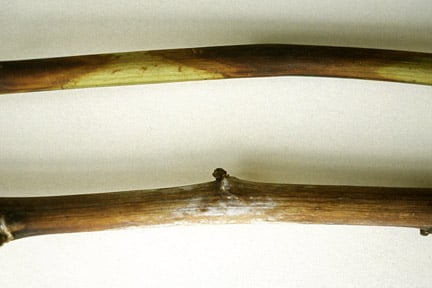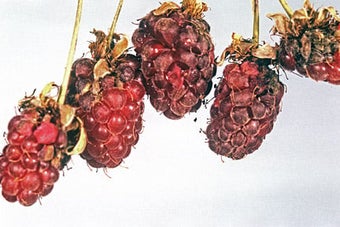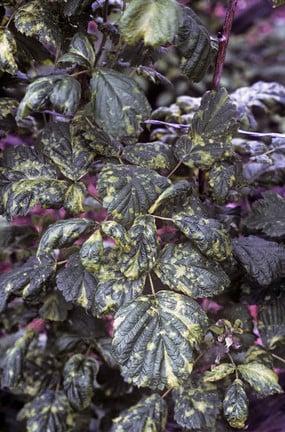
Quick facts
Common name - Raspberry spur blight
Scientific name - Xenodidymella applanata
Plants affected - Raspberries
Main symptoms - Purple and then silvery-grey patches on canes, dead buds and shoot dieback
Caused by - Fungus
Timing - First symptoms seen in late summer
What is spur blight?
Spur blight is a disease of raspberries caused by the fungus Xenodidymella applanata. It appears from late summer and persists on infected canes until the following year.
It mainly affects raspberries and occasionally loganberries. It is particularly common during wet seasons.
Symptoms
You may see the following symptoms:
- Conspicuous purple patches on new canes in late summer, centred around the . They increase in size, spreading up and down the from the point of infection
- As autumn and winter progress the patches become less distinct, fading to a pale grey or silvery colour. Fruiting bodies of the causal fungus may be visible as tiny black dots on the affected areas
- Many of the buds on canes, infected the previous year, fail to grow in spring or produce weak shoots that soon die. These canes appear bare and unthrifty compared to their healthy counterparts

Control
Non-chemical control
- Avoid overcrowding by out any young canes that are not required. This should be done as early in the spring as possible
- Avoid the over-application of nitrogen
- If spur blight develops, cut out and dispose of badly affected canes
- Choose resistant cultivars. The cultivars ‘Glen Lyon’, ‘Glen Moy’ , ‘Glen Rosa’, ‘Julia’, ‘Leo’ and ‘Malling Admiral’ have some resistance to spur blight
Chemical control
No fungicides are available to home gardeners for the control of raspberry spur blight.
Biology
Xenodidymella applanata produces two spore types. The first type starts the infection on the new canes in the spring, while the second causes further spread during the summer. Infection usually occurs via the leaf stalks or , and is favoured by wet weather.
Overcrowded canes, and those that have received too much nitrogen, are more prone to attack.





